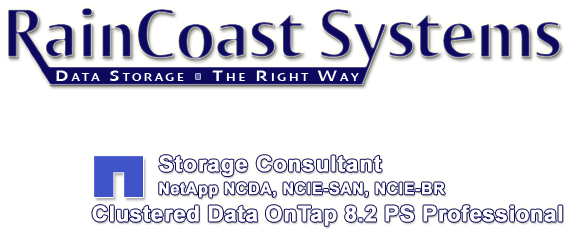

RainCoast Systems is a niche IT company located on the west coast of Canada and has been operating since 2002. The primary focus of RainCoast is to provide expert level data storage consulting with an emphasis on integrating NetApp and IBM N-Series hardware and software in medium to large data centre environments. One of our key strengths is in helping customers take advantage of the benefits provided by a centralized storage architecture, specific to NetApp. Benefits that include, rapid on disk backups that shrink backup windows to minutes and allow very fast recoveries, highly optimized replication over wide area networks and rapid data cloning for development and test environments. We also provide onsite, flexible custom NetApp training for technical staff that is far more cost effective than traditional classroom training sessions.
We have customers from coast to coast across Canada and the Caribbean.
- With 10 years of experience implementing NetApp solutions, we are an excellent choice for customers who are either looking to setup and configure new NetApp or N-Series storage or take advantage of their existing equipment's full potential.
Centralized storage touches upon virtually every aspect of data centre operations and we have expertise on all of the major players and components and how to best integrate them into a holistic solution. Areas such as networking, backups, server and desktop virtualization (with an emphasis on VMware), Oracle, Microsoft SQL Server, Exchange, Sharepoint and of course data migration.

While our focus is in key areas such as data storage and server administration, RainCoast does have a versatility that is rare in a field of narrowly focused skill sets. We also have proficiency in areas such as VMware, network design and implementation, Windows networks and a whole array of technically challenging but interesting projects.
- NetApp HW
Deployment - NetApp SW
Deployment - NetApp VMware
Integration - NetApp
Training - System
Health Checks - Data
Migration - Data
Protection
NetApp VMware Integration
Well over 50% of our engagements include integration of NetApp storage into virtualized environments. We have completed many virtualization projects performing setup and configuration of a complete VMware environment including ESX host builds, VCenter servers, P2Vs of physical servers as well as storage provisioning using FC or NFS attached datastores. All of which is performed according to current NetApp and VMware best practices.
We also provide assistance with or completely manage VMware upgrades and have performed over a dozen 4.1 to 5.0 rollouts in the last year.
Finally, we are also very experienced with deploying VMware's Site Recovery Manager (SRM) using NetApp storage as the backend. In our opinion, SRM and NetApp provide best of breed Disaster Recovery, making DR testing and failover extremely easy to perform.
System Health Checks
We often get a call to come in, review the existing environment and provide a set of recommendations. We call this our NetApp Health Check.
The health check typically includes an interview with your storage team to gain an understanding of your current use of the storage, an inventory of all hosts and the methods of storage provisioning such as FCP, NFS or iSCSI, a complete review of the NetApp configuration including network, a complete inventory of all NetApp volumes and LUNs and a review of the system logs looking for issues or pending problems.
With all that information gathered, we then produce a detailed report of our findings including recommendations. We commonly find areas of concern that are just waiting to happen. It is not uncommon for a NetApp controller to be deployed and then left untouched for months. While they run very well, they do need an occasional set of experienced eyes to make sure things are as they should be.
Our reports are always very well received and commonly result in a much better utilization of existing storage based on our recommendations for use of things like deduplication and thin provisioning.
Data Migration
We have migrated petabytes of data over the years and whether it is file and print data from an old Windows server, production Oracle or SQL databases, Exchange mailstores or Virtual Machines, we have done it all.
Data migration is inherently a very detailed oriented task, especially Windows files. We take particular pride in ensuring that every file makes it from old storage to new with file permissions intact. Our track record is impeccable; we've never lost data in all of our years of providing these services.
In complex environments where millions of files and hundreds of shares exist, we can automate the process with PowerShell scripts to ensure every single detail is captured and mirrored to new storage.
We know data very well.
Data Protection
Regular backup of your critical data is a crucial part of data centre operations as is the replication of your critical data to a DR site. Even more important is the ability to restore from those backups or test failover at your DR site. We have helped dozens of customers leverage NetApp's SnapVault, SnapMirror and SnapProtect technology to make this process easy.
We have deployed dozens of SnapVault projects which allow you to keep a small number of on disk backups of your data in the form of on disk snapshots as well as a much higher number of backups on remote disks. This data can either live natively on NetApp disk or on a variety of hosts which can then replicate data using NetApp's Open Systems SnapVault (OSSV).
We've also helped hundreds of customers use SnapMirror to efficiently replicate terabytes of data across the country or the world to their DR sites. Not only can we help you get it there, we can help you leverage that data once it's there using FlexClone technology to utilize those copies for DEV and Test environments making that remote copy even more useful and cost effective.
Finally, we can help you manage all of your enterprise backups from a single pane of glass using SnapProtect. This relatively new offering from NetApp is one of the best software products it has released in years. Leveraging the industry's best of breed enterprise backup solutions in CommVault's Simpana 9, NetApp has been able to integrate it with their Snapshot technology to enable extremely fast, highly space efficient backups, regardless of the application or data type. We absolutely love this product.

While he doesn't look it, Paul has been in the field of computers for a long time. Starting his career with a Diploma of Computing Technology in 1988, he spent a few years as a database programmer hidden from the world in a cubby hole. The food was bad and so were his social prospects but the experience taught him a lot about the world of databases providing knowledge that has been very useful in his current role.
|


| Paul Barrette | |||||||||||||
|
|
||||||||||||
|
|
||||||||||||
 While we occasionally utilize other resources for specialized skill sets, RainCoast Systems is essentially Paul Barrette.
While we occasionally utilize other resources for specialized skill sets, RainCoast Systems is essentially Paul Barrette.
